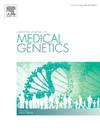Seven loci associated with schizophrenia and bipolar I disorder in selected southern African population groups
IF 1.7
4区 医学
Q3 GENETICS & HEREDITY
引用次数: 0
Abstract
Two major psychiatric disorders, schizophrenia and bipolar I disorder, are regarded as distinct disorder entities; however, they share intricate connections through characteristic overlap and underlying genetic aetiology, challenging the traditional dichotomy. This convergence emerged as an essential area of investigation in understanding the genetic determinants of schizophrenia and bipolar I disorder. Moreover, psychiatric genetic research has revealed demographic disparities, with South African population groups notably underrepresented. Therefore, this preliminary targeted candidate gene association study of 20 single nucleotide polymorphisms implicated in schizophrenia and bipolar I disorder aimed to investigate association and overlap. Candidate loci for schizophrenia and bipolar I disorder were selected through an exploratory Illumina® Infinium PsychArray-24 analysis combined with literature and database searches. Genotyping of the selected loci was performed with the Agena Bioscience MassARRAY® platform on 96 cases (58 schizophrenia and 38 bipolar I disorder patients) and 44 controls of Afrikaner, Sotho, and Tswana descent. Association analysis was performed by comparing and combining population and phenotype groups. Significant (p < 0.05) loci in the ADAMTSL1, CACNA1B, CACNA1C, CDH13, CTNNA2, RBFOX1, and TRIO genes were identified as possible susceptibility factors, and differences were observed with the association between population and phenotype groups. Through further pathway analysis, the calcium and cadherin-catenin pathways were identified as possible role players in the aetiology of schizophrenia and bipolar I disorder. The study represented an essential step towards understanding the genetic contribution towards schizophrenia and bipolar I disorder in distinct population groups and has the potential to contribute towards the knowledge base and inform future research efforts.
在选定的南部非洲人群中,与精神分裂症和I型双相情感障碍相关的7个基因座。
两种主要的精神疾病,精神分裂症和双相I型精神障碍,被视为不同的精神障碍实体;然而,它们通过特征重叠和潜在的遗传病因共享复杂的联系,挑战了传统的二分法。在理解精神分裂症和双相I型障碍的遗传决定因素方面,这种趋同成为一个重要的研究领域。此外,精神病学基因研究揭示了人口统计学上的差异,南非人口群体的代表性明显不足。因此,这项针对20个与精神分裂症和双相I型障碍相关的单核苷酸多态性的初步靶向候选基因关联研究旨在研究关联和重叠。通过探索性Illumina®Infinium PsychArray-24分析,结合文献和数据库检索,选择精神分裂症和双相I型障碍的候选基因座。使用Agena Bioscience MassARRAY®平台对96例(58例精神分裂症患者和38例双相I型障碍患者)和44例阿非利卡人、索托人和茨瓦纳人血统的对照进行了所选位点的基因分型。通过比较和组合群体和表型组进行关联分析。在ADAMTSL1、CACNA1B、CACNA1C、CDH13、CTNNA2、RBFOX1和TRIO基因中发现显著(p < 0.05)的位点可能是易感因素,并观察群体和表型组之间的差异。通过进一步的通路分析,钙和钙粘蛋白-连环蛋白通路被确定为精神分裂症和双相I型障碍病因学中的可能角色参与者。这项研究代表了了解不同人群中精神分裂症和双相I型障碍的遗传贡献的重要一步,并有可能为知识库做出贡献,并为未来的研究工作提供信息。
本文章由计算机程序翻译,如有差异,请以英文原文为准。
求助全文
约1分钟内获得全文
求助全文
来源期刊
CiteScore
4.10
自引率
0.00%
发文量
193
审稿时长
66 days
期刊介绍:
The European Journal of Medical Genetics (EJMG) is a peer-reviewed journal that publishes articles in English on various aspects of human and medical genetics and of the genetics of experimental models.
Original clinical and experimental research articles, short clinical reports, review articles and letters to the editor are welcome on topics such as :
• Dysmorphology and syndrome delineation
• Molecular genetics and molecular cytogenetics of inherited disorders
• Clinical applications of genomics and nextgen sequencing technologies
• Syndromal cancer genetics
• Behavioral genetics
• Community genetics
• Fetal pathology and prenatal diagnosis
• Genetic counseling.

 求助内容:
求助内容: 应助结果提醒方式:
应助结果提醒方式:


